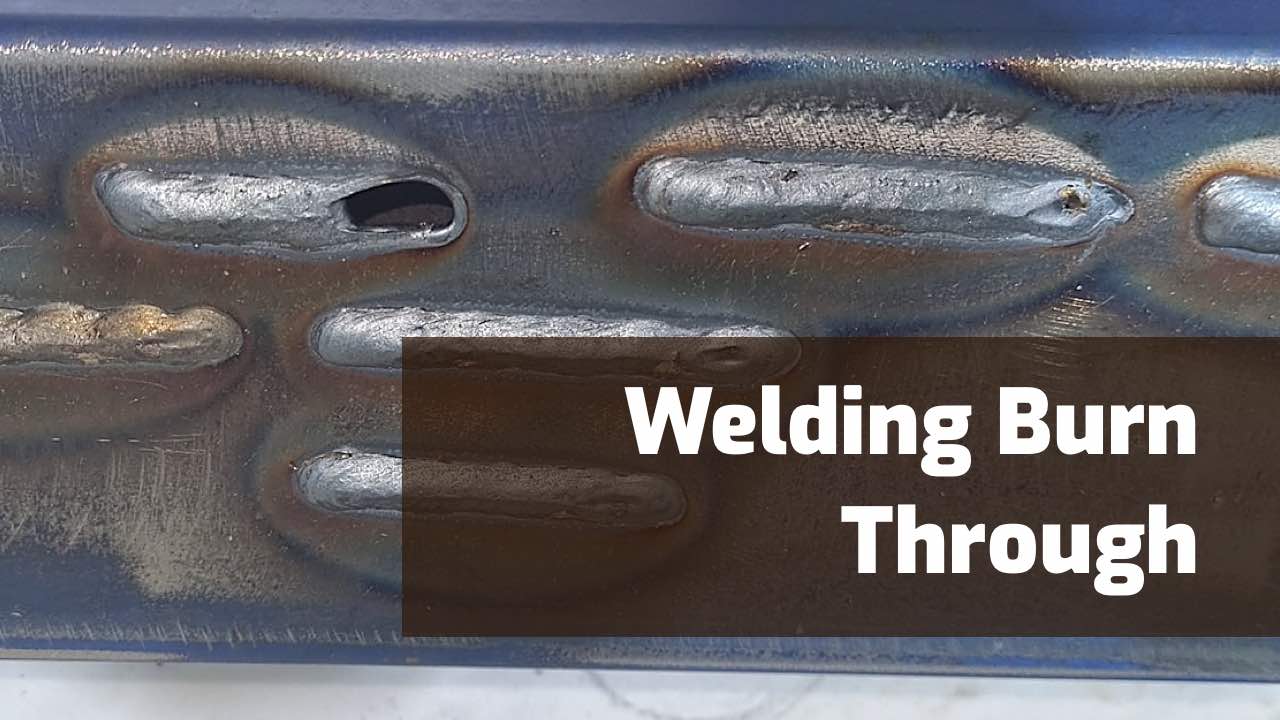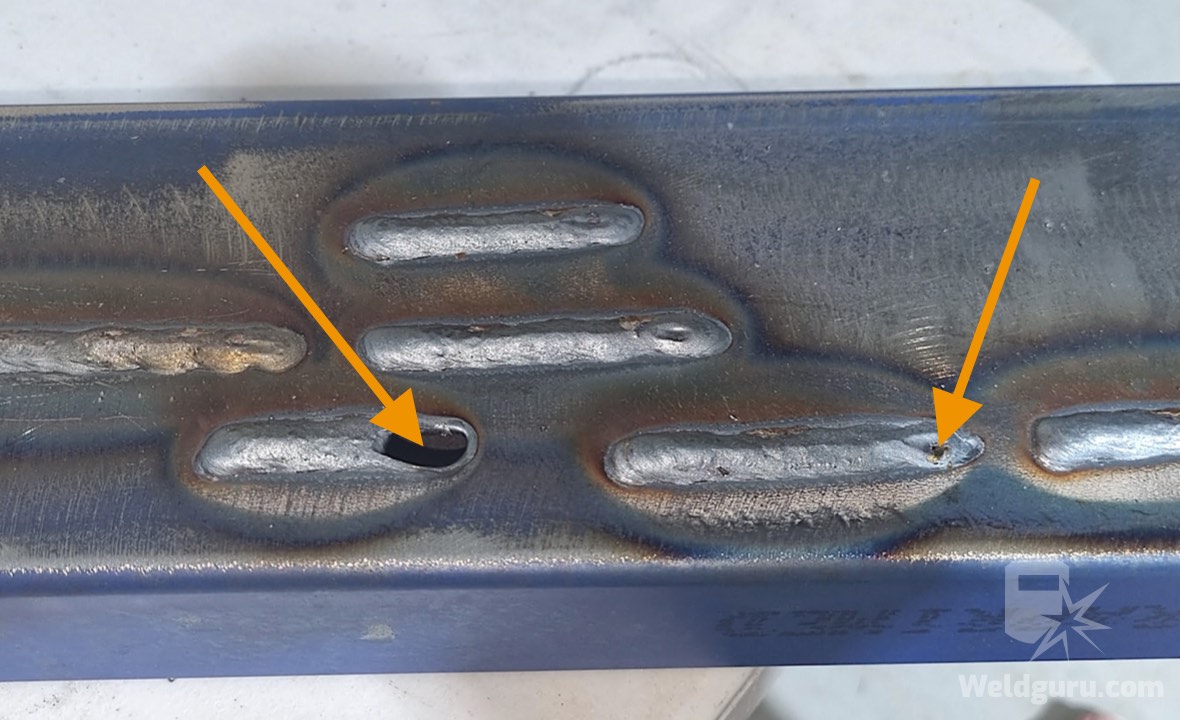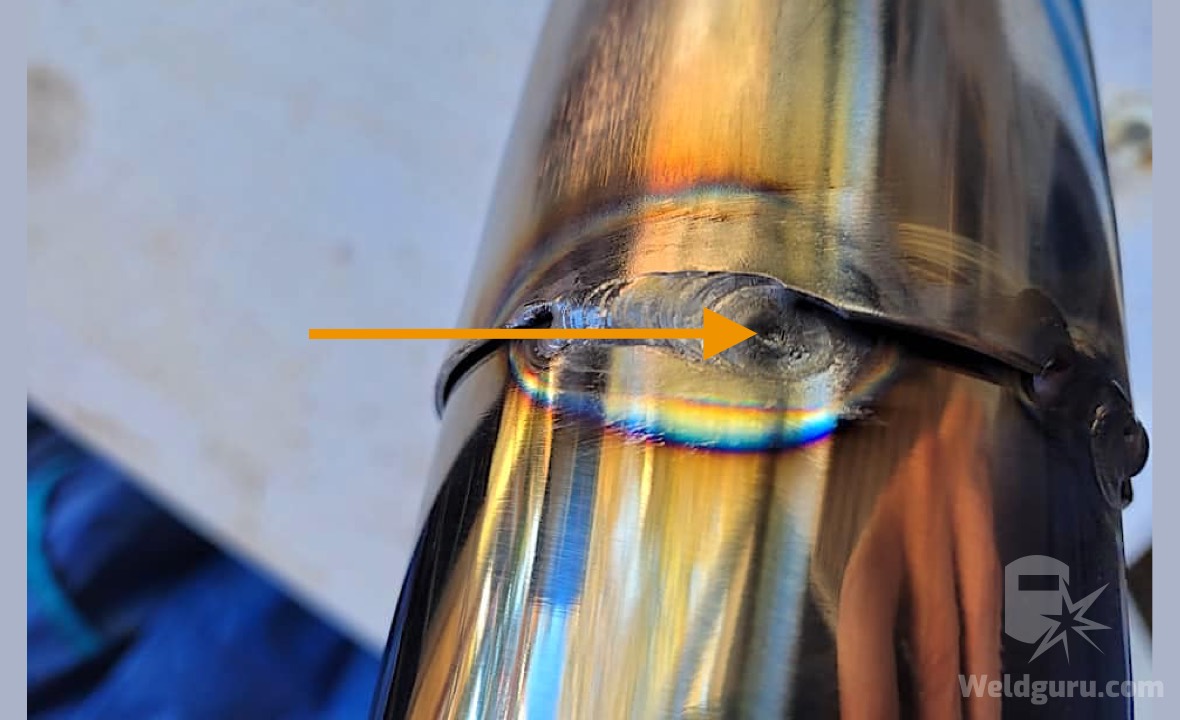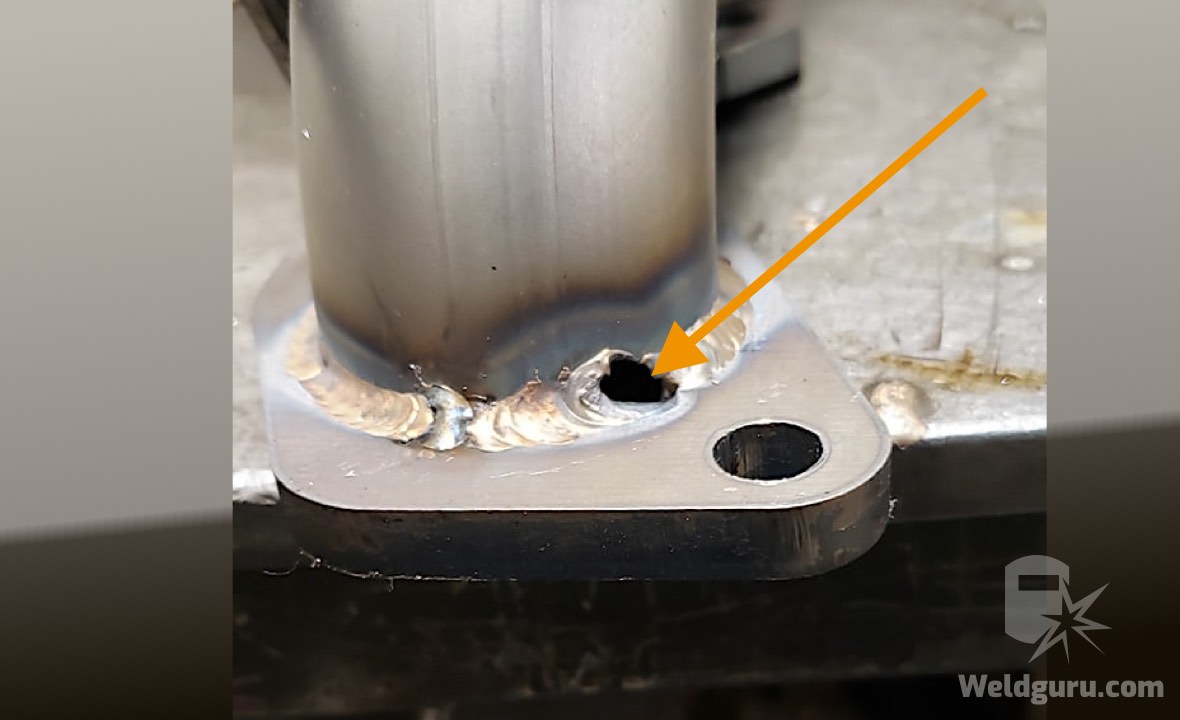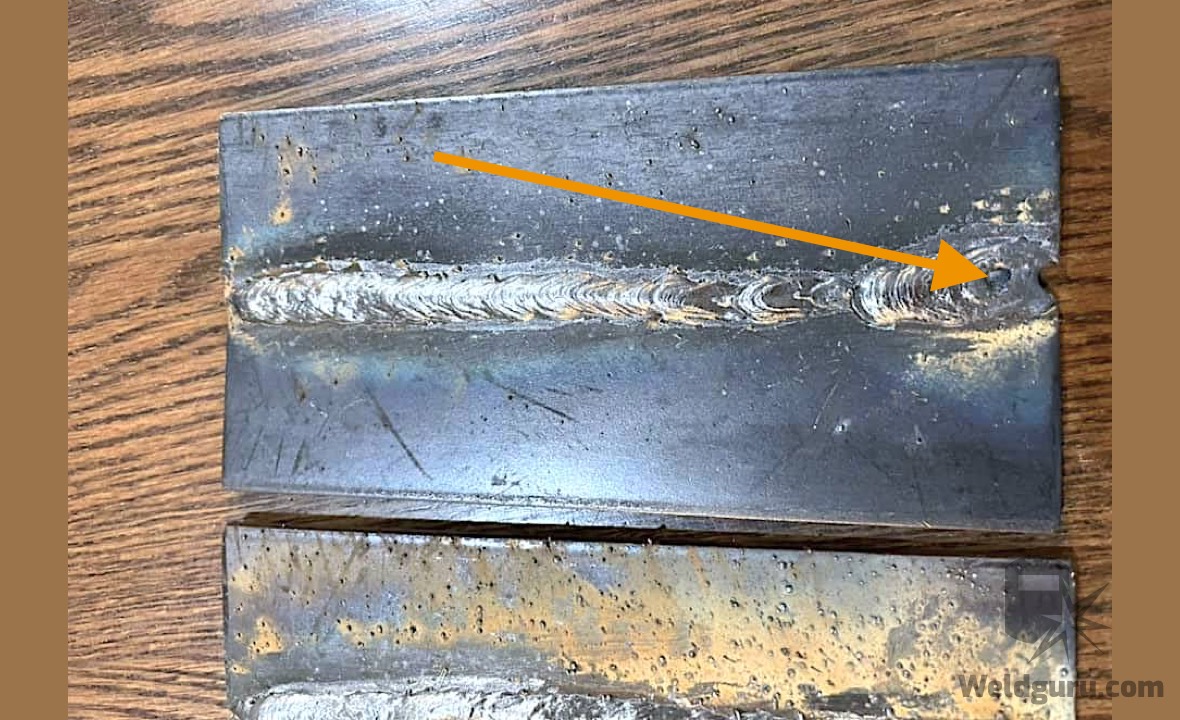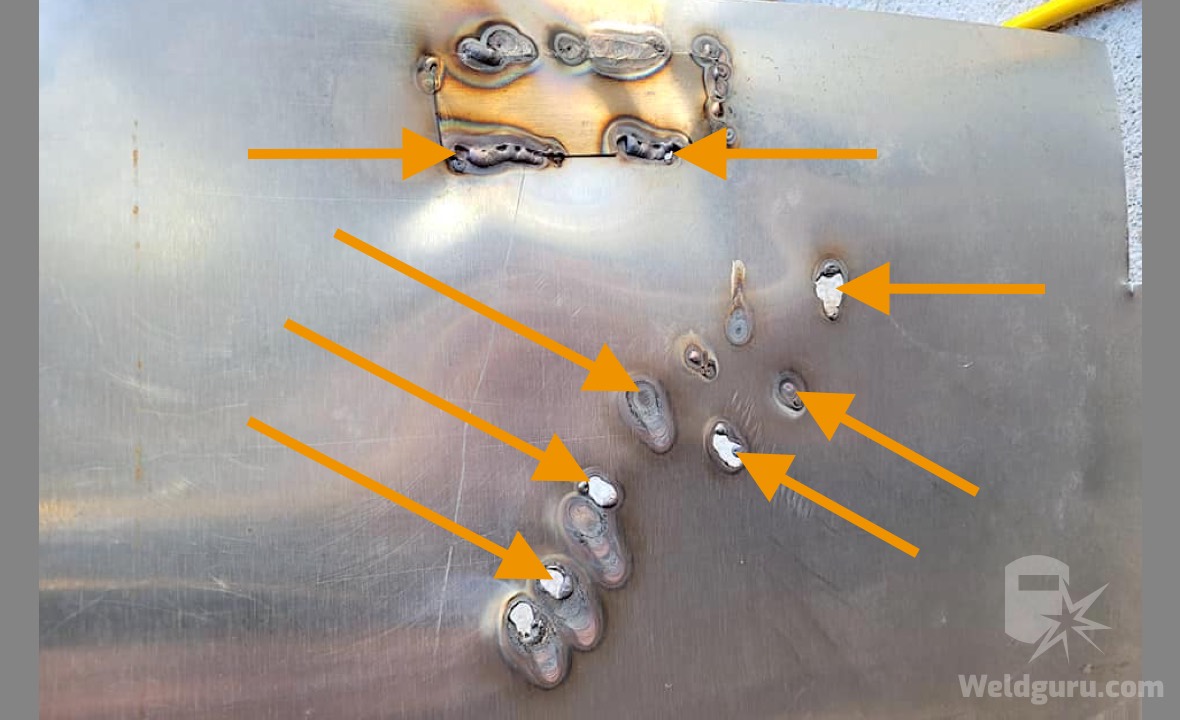Burn-through is a common defect in welding. It is encountered frequently in a welding shop, especially by those still learning.
As with all defects, burn-through creates many problems. The worst-case scenarios are part rejection or weld failure.
Luckily, burn-through can be easily avoided with a bit of care and some knowledge. So, in this article, we will explain what burn-through is, why it is bad, what causes it, as well as how to correct and prevent it.
What is Burn-Through?
Burn-through occurs when the weld penetrates deep enough to reach the weld root. Basically, you accidentally melt the entire base metal thickness. This is why burn-through is also known as melt-through.
As a result, it appears as a hole in the finished weld joint. Typically, this defect occurs right on the weld seam or near it. It is also more common in thinner workpieces and materials with low thermal conductivity.
There are a number of causes which we will discuss one-by-one. However, it is important first to know why burn-through should be avoided.
Why is Burn-Through Bad?
Burn-through can severely decrease joint strength. Naturally, you know a discontinuity in any weld makes it weak. Therefore, gaps and holes become points more likely to crack or deform under load. That is not what you want people to associate with your welds.
In pipe welding, burn-through brings an immediate rejection 100% of the time. A leaky pipe joint will certainly not serve its intended purpose.
Burn-through also ruins the aesthetics of a weld. This may not be a functional requirement, but appearance matters for most clients. If you experience burn-through in your welds, go the extra mile to fix it so it looks better. You will feel more pride in your work, guaranteed!
What Causes Burn-Through?
There are several reasons for burn-through. They are linked to welding parameters, technique, joint preparation, etc. So, you need to be careful about the entire setup and execution when tackling burn-through.
High Amperage
Most of the time, burn-through occurs due to excessive heat input into the weld joint Heat input is mainly dependent on amperage (or current). So, the higher the current, the greater the heat input.
If you see burn-through in your weld, double-checking your amperage level should be the first thing you do. There is a recommended amperage for each job that you can easily find from catalogs, charts, or your instructor. Ensure your amperage is not too high for the job.
Slow Travel Speed
Electrode travel speed also impacts the heat input. Moving the electrode slowly, you spend more time on the weld pass. The longer you dwell on the joint, the greater the heat input.
The effect is the same as discussed above. High heat input leads to over-melting and increases the possibility of burn-throughs.
You can find recommended travel speeds in charts or catalogs. However, these are unlikely to be helpful since you do not know your actual travel speed while welding. You can only get this right with lots of practice and focus. If you see burn-throughs often, you may be moving too slow.
Improper Joint Penetration
One of the main reasons for burn-through is poor joint preparation. Correct parameters and techniques will be of no help if you are lazy with tasks that come before striking an arc.
There are two ways to categorize the joint preparation quality, excess grinding and poor cleaning.
Grinding Too Much Base Metal
The base metal edges are often beveled before welding. This allows the filler material to fill and form the joint properly. The edge beveling is usually done by grinding.
You must be extra careful during this grinding process. A little over-grinding can create bevels that are deeper than needed. This extra depth makes the joint more prone to melt through.
Insufficient Base Metal Cleaning
Base metals need to be properly cleaned before you can weld on them. Like galvanized steels or aluminum, many metals have protective layers on their surface that become highly reactive at high temperatures.
Aluminum oxide, for example, is present as a thin film on every aluminum piece in your shop. It is good in the sense that it protects aluminum from corrosion. But it is bad for welders as the oxide layer reacts violently with hot metals in the weld pool, creating spatter and impurities.
This reaction makes it difficult to control the weld pool, which tries to move away from the weld zone. It leads to burn-through as heat from the torch goes in the base metal rather than being absorbed by the weld pool.
Cleaning the base metal is important to avoid these types of problems. A wire brush or small grinder is enough to remove these coatings, layers, films, etc., and prepare a smooth, clean workpiece.
Incorrect Arc Length
Arc length is the distance between the workpiece and the electrode tip.
The arc is longer if you keep the electrode too far away from the base metal. This creates an unstable, discontinuous arc and causes spatter. This also makes it difficult to control the arc’s movement and properly manage the heat deposition.
As a result, excessive melting can occur in the weld area, leading to burn-through.
You should be careful, however. Moving the electrode close to the workpiece also causes the current to rise. As mentioned above, high current also causes burn-through.
So you have to find the upper and lower limits for arc length and stick to this range to prevent burn-through.
Steep Travel Angle
The travel angle is how much you “tilt” the electrode/stick during welding. But most important for this discussion, this angle affects heat input.
If the travel angle is too steep (almost vertical to the metal), most of the weld energy is focused directly into the weld pool. On the other hand, increasing the travel angle distributes the heat in a wider area.
So, yes, you might have guessed it already! Avoid steep travel angles if you want no burn-through.
Poor Welding Technique
In short, good welds rely on a welder’s skill and technique. All the remedies discussed above will not help if you use a bad technique.
Highlighted below are two technical mistakes that young welders often make.
Dragging Along the Weld Seam
There are two ways to hold the electrode while welding. You either bend the stick towards the travel direction or away from it. Welders usually refer to the first one as “dragging” the weld. It is also called “pulling” the bead. However, dragging can create burn-through issues.
When you drag a weld, some of the weld energy is directed towards the metal about to be welded. So some heat goes in the weld pool, and the rest pre-heats the portion you are moving towards.
This increases the total heat input into the joint, which we know by now is the leading cause for burn-through. So be careful when angling your electrode with reference to the travel direction.
Moving the Stick in Patterns
This is a classic rookie mistake. Many beginners are eager to create good-looking welds. Stringer or weaved beads look very neat, so rookies develop a habit of overusing these techniques.
These patterned beads may look good, but you must also consider the downsides. For example, when you weave, you spend more time on each pass. This allows more heat to enter the weld joint, and with greater heat input, the risk of melt-through increases.
Wrong Welding Type
Choosing the right welding process for a job is a science. There are many welding techniques nowadays, from common processes like MIG to rare ones like friction stir.
If your concern is burn-through, you should avoid high-intensity welding types. Arc welding has a much larger heat input (energy density) than other welding processes. This is why welders prefer low-intensity processes like MIG for thinner workpieces.
Ultimately, like many things in welding, there is no substitute for on-the-job knowledge. Hands-on experience will help you learn what welding process works best for your work. Practice often and do trials or test pieces when you are unsure.
Incorrect Machine Settings
There are a number of buttons and knobs on a welding machine that are rarely touched. You may change the amperage and wire feed speed from time to time. But polarity, for example, usually stays the same.
Before starting welding, you should cross-check all your welder settings to ensure everything is as you need it.
Polarity, voltage, pulse settings, etc., may have been changed for another job. If those changes go unnoticed, they can be the cause of burn-through and other defects. So, always check and recheck to ensure you have the right settings before welding.
10 Quick Tips to Avoid Welding Burn-Through
- Use a lower current level: Decrease the current setting for lower heat input.
- Weld quicker: Try to complete passes as quickly as possible to decrease chances of burn-through.
- Avoid over-grinding the base metal edges: When grinding bevels, make sure to leave some material at the bottom so it can withstand the high welding temperatures.
- Clean everything before welding: Take time to clean the welding surfaces with a metal brush or grinder to remove surface coatings, layers, rust/dirt, or any other contamination.
- Maintain a moderate arc length: Keep it constant at the recommended length (equal to the diameter of the electrode). Anything over or under, and you start to see burn-through.
- Use a shallow travel angle: Try not to hold the electrode vertical when welding; maintain the proper inclination for the entire joint.
- Push, don’t Pull: If you see burn-through while dragging, consider reversing your travel direction with the same electrode angles. It shifts heat deposition to the bead rather than the base metal.
- Avoid unnecessary patterns: Stringers and weaving may look good, but a straight line pass is ideal for eliminating burn-through.
- Consider mild welding types: Use low-intensity techniques like MIG or TIG if possible.
- Verify machine settings before welding: Cross-check all settings before beginning the job to decrease the odds that defects will form. This is the mark of a true professional.
How to Fix Burn-Through?
Experience does not guarantee that you will never make mistakes. Defects still happen, which is why the welding community has developed techniques to fix them.
Burn-through is no exception. It frequently occurs in professional welding shops, and you must know how to fix it.
Since burn-through is just a hole, filling it is the obvious solution. If it is a small hole, tack a small weld on that spot. If it has rough edges, you may want to grind them off before adding filler.
Sometimes, you may experience multiple burn-throughs throughout the entire joint. To fix this, simply make another pass over the existing one, keeping in mind the advice we provided in this article.
Conclusions
Burn-through is dependent on many variables. It may be a product of bad parameters like high current and travel speed. In some cases, negligence in joint preparation can be the cause.
We also learned that specific welding techniques like stringer beads could also cause burn-through. This may have come as a surprise, but it’s true. Welding is a complex art. You must keep an eye on every aspect of your setup. Any part of it can cause burn-through problems.
So, in conclusion, burn-through is not something you can avoid completely. All you can do is be careful and practice as much as possible. There is no substitute for hands-on experience.
Your goal is to minimize the problem. This problem will never go away, even for the most experienced welders. So, be optimistic about your mistakes and learn from them. It’s how you become a better welder.
